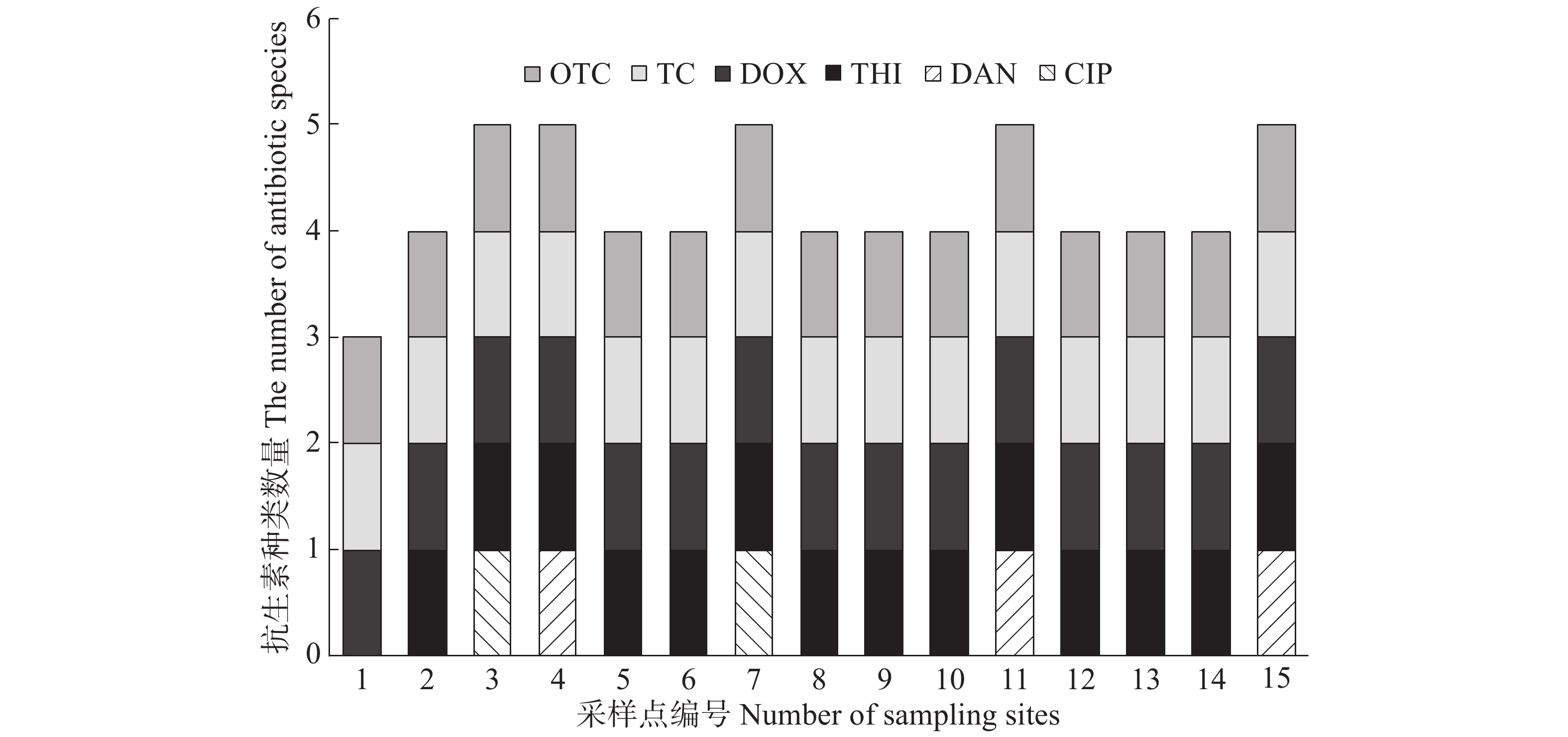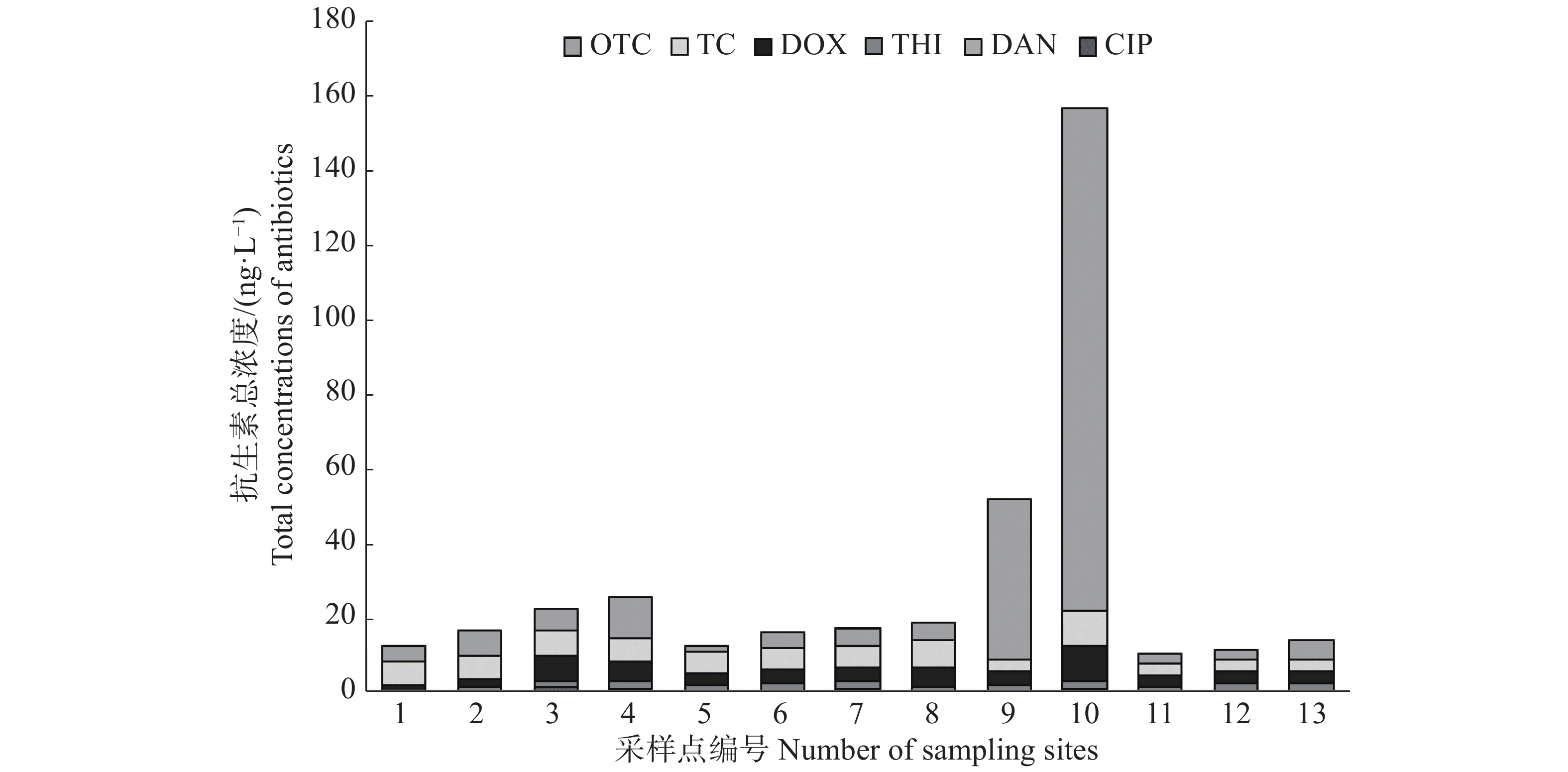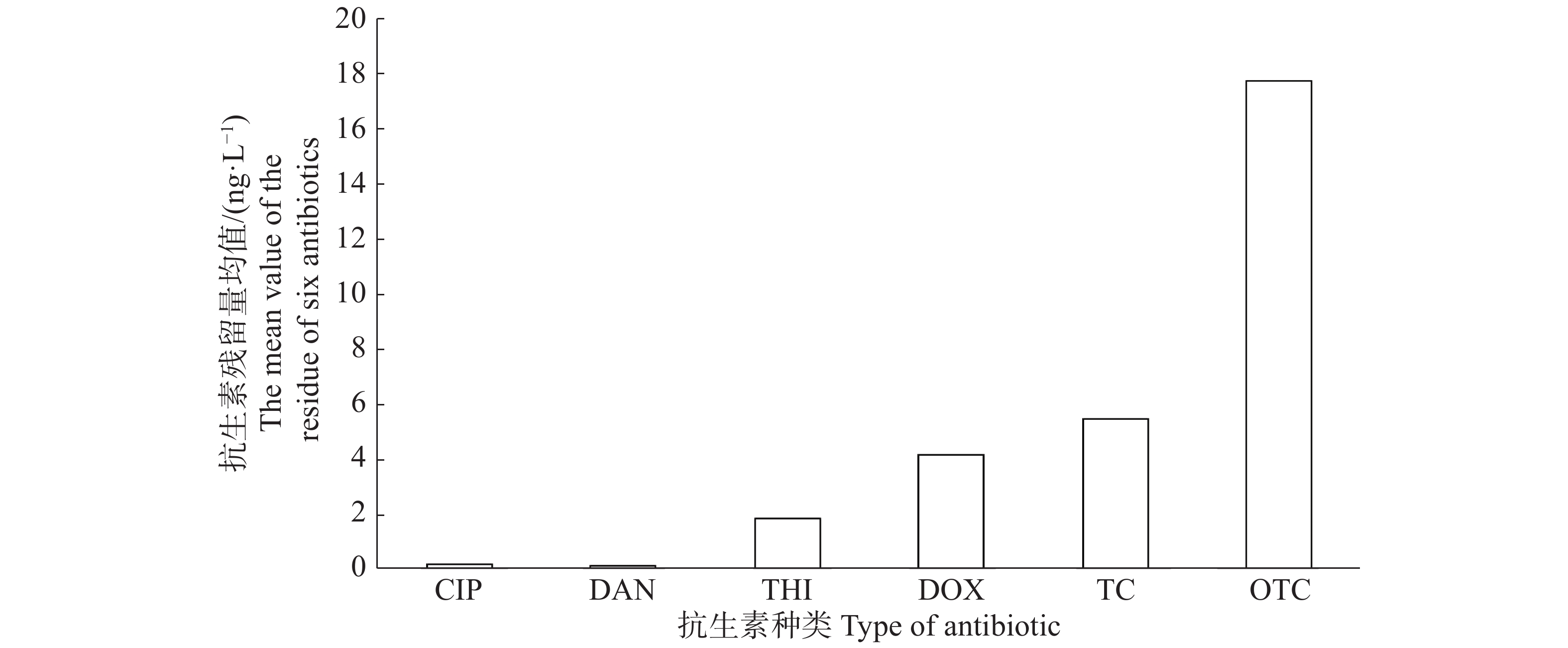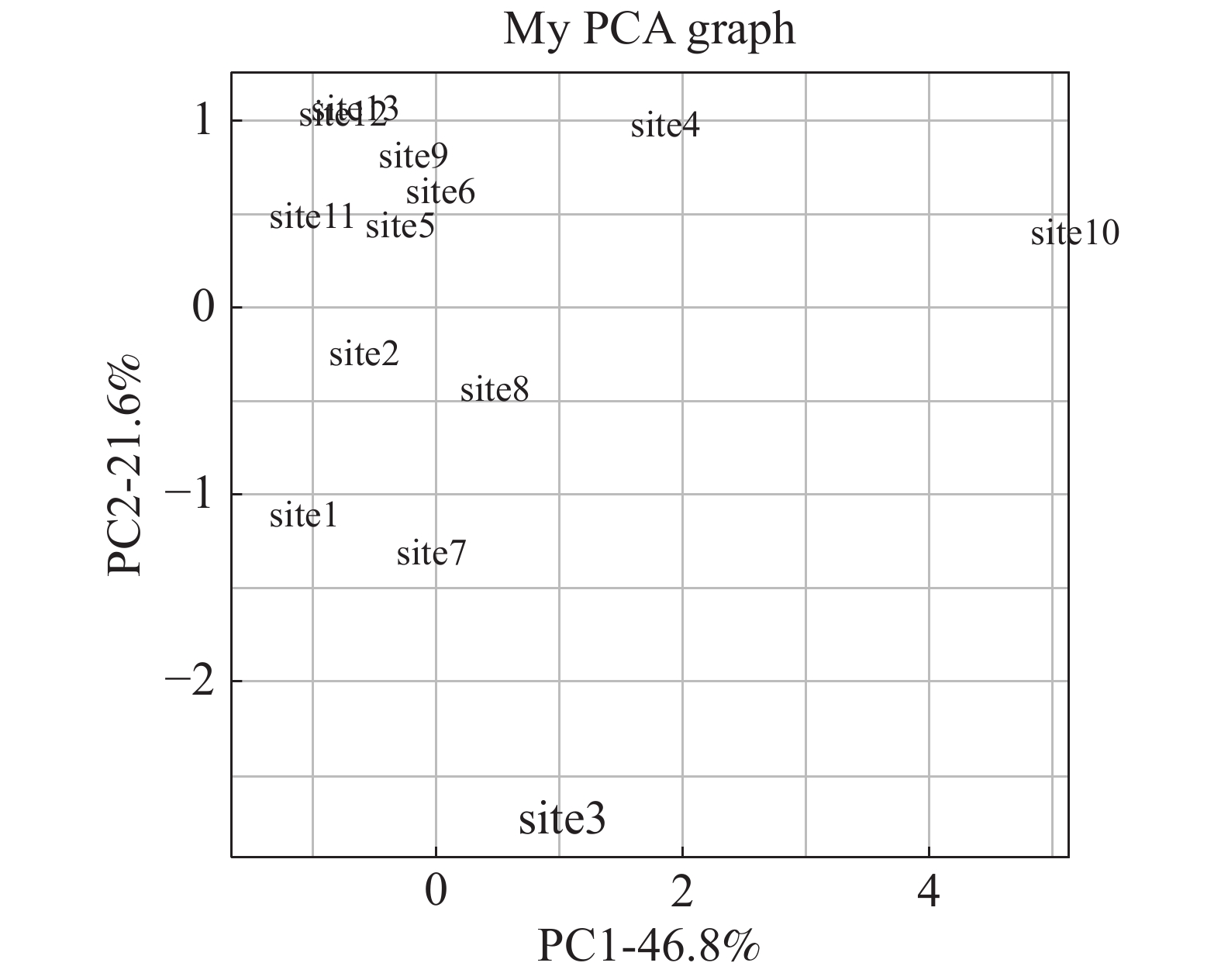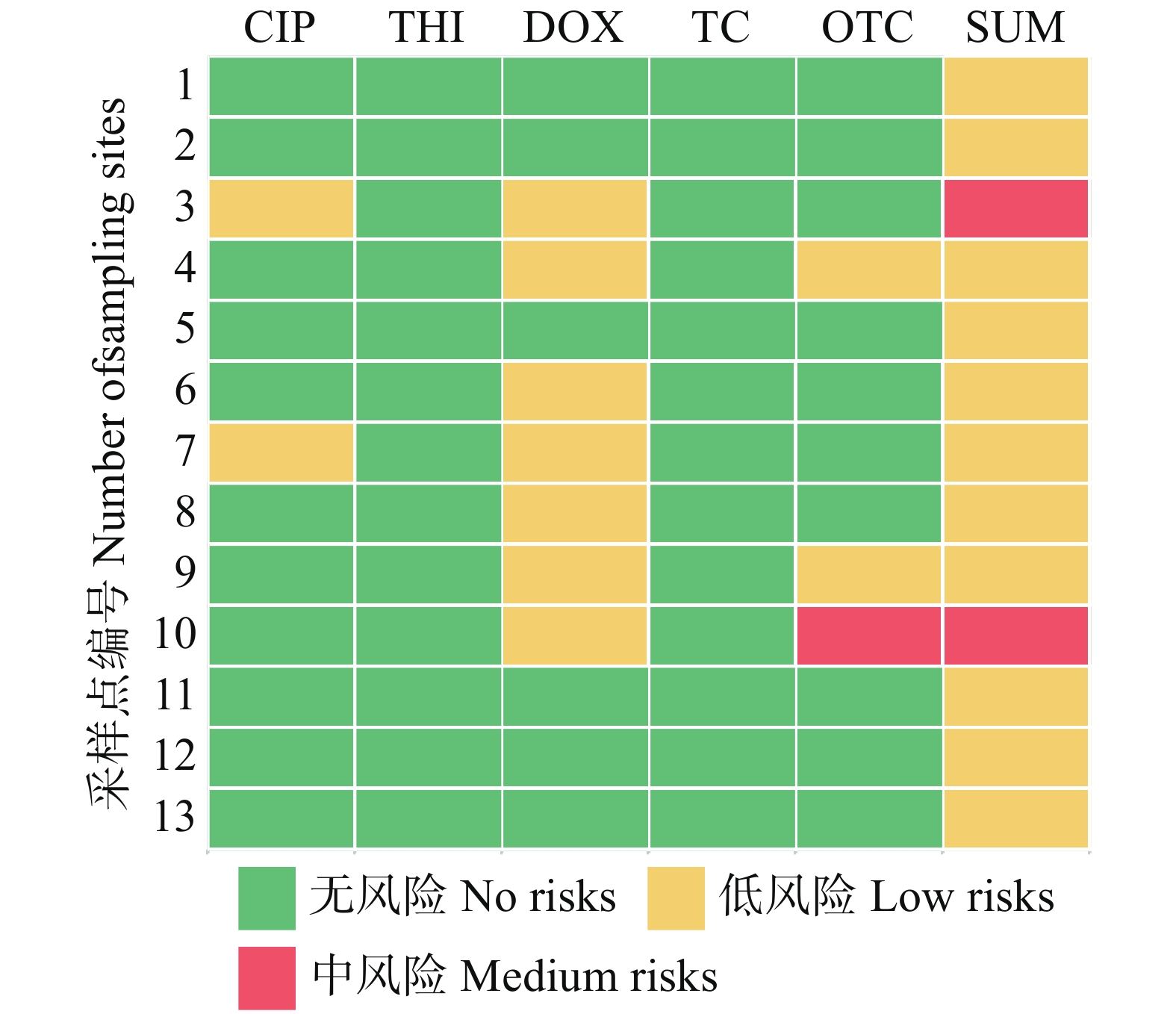-
抗生素种类繁杂,现已达到几千种,按照其化学结构主要分为β−内酰胺类、四环素类、喹诺酮类、大环内酯类、磺胺类、氨基糖苷类和氯霉素等,并且在多种环境介质中广泛存在。水体中抗生素污染的来源主要有医用、养殖业及制药工业废水排放。抗生素被使用后并不会被生物体完全吸收。残留抗生素以多种形式经各种途径排入水体等环境中,造成环境污染。国内的其他水环境(如地表径流、地下水、海洋等)中都能检测到抗生素的残留。不同水域间的抗生素残留量差别很大,残留量最高的是养殖废水。磺胺类、喹诺酮类、四环素类及氯霉素类等4类抗生素由于具有较好的防治疾病和促生长等作用而被广泛使用于水产养殖等行业,以达到治疗、预防动物传染性疾病和促进动物生长的目的[1-3]。水产养殖废水的排放是水环境中抗生素污染的重要的人为来源。陵水新村、黎安港和万宁小海海域是海南省重点海水养殖集中区,具有重要的生态及经济价值[4]。新村港位于海南省陵水县新村镇的东南部,港内南北长4 km,东西宽6 km,面积24 km2,拥有上千家鱼排,养殖着金鼓鳗鱼、珍珠龙胆等鱼类。万宁小海现面积约43 km2,周长约43 km,小海物产丰富,著名的和乐蟹、港北对虾和后安鲻鱼均产于此。调查区域主要为浅海养殖中的网箱养殖。网箱的主要结构是框架和网衣,框架起到支撑固定网衣的作用,网箱面积可达到数十平方米,深度约为2~4 m。网衣上常附着水藻、微生物等多种物质。浮动式网箱能随着水位的变化而上下浮动,在养殖中使用广泛,常用于养殖鱼类、螃蟹[5]。有研究表明,海南省每年每平方米的抗生素排放量处于我国相对较高水平[6],但重要水产养殖区域养殖水体中抗生素的分布特征鲜见系统报道。为此,本研究采集海南岛东部陵水新村、黎安港和万宁小海,海域养殖区的海水样品,通过LC-MS/MS 技术对样品中4类(磺胺类、喹诺酮类、四环素类及氯霉素类)40种抗生素进行定量分析,以揭示养殖区海水中抗生素残留的分布情况并进行生态风险评估,同时为养殖区生态水质监测和环境保护提供科学支持。
HTML
-
本研究于2018年8月采集陵水新村、黎安港和万宁小海养殖区海域表层海水样本,共采集样品15个,采样点分布见图1。同一采样点以棕色玻璃瓶采集1 L水样。水样采集时取同一截面水平面0.5 cm以下左中右3个点的混合样,每个样点采集3个重复。水样置于4 ℃冰盒中避光冷藏保存,并于48 h内进行前处理。采样时详细记录监测点位的水温、pH值、溶解氧和盐度等。
-
本研究对4类(磺胺类、喹诺酮类、四环素类、氯霉素类)40种抗生素进行检测,检测方法参照文献[7]。
-
取1 L已过滤水样,用盐酸-水溶液(V盐酸∶V水=1∶1)调节pH至2.5。依次用20 mL甲醇、6 mL超纯水、6 mL盐酸(pH2.5)对HLB柱进行活化。用已活化HLB柱对水样进行富集,流速控制在5 mL·min−1 左右。富集完成后用氮气轻柔吹干富集小柱,将氮吹干燥后的小柱用12 mL甲醇进行洗脱,收集洗脱液。洗脱液氮吹浓缩至近干。用流动相95%A(0.1%甲酸−1 g·L−1甲酸铵水溶液)和5%B(V甲醇∶V乙腈=1∶1)定容至1 mL,过0.22 μm尼龙滤膜,待测。
-
进样量10 mL,柱温40 ℃,流速0.30 mL·min−1。流动相A:0.1%甲酸−1 g·L−1甲酸铵水溶液;流动相B:V甲醇∶V乙腈=1∶1。梯度洗脱程序:起始5%B 3 min,然后在18 min内从5%B线性变化至88%B。质谱离子源:ESI+/ESI−切换,MRM数据采集模式。待检抗生素中氯霉素类抗生素采用负离子模式,其余抗生素采用正离子模式。
-
为研究抗生素在采样区水体中抗生素对水生生物的生态风险,采用风险熵值(RQs)来评估。风险熵值法(RQs)来自欧盟的技术指导文件(European commission technical guidance document, TGD),药品在环境中的生态风险可以根据风险熵值(RQs)大小来评估,此方法被广泛应用于分析废水和地表水中常检测到的药物环境风险。RQs通过污染物的环境实测浓度与预测无效应浓度的比值获得,公式如下:
式中:MEC为抗生素的实测质量浓度,ng·L−1;PNEC为预测无效应浓度,即不会对生态环境产生不良影响的最大质量浓度,ng·L−1。
有研究[8-11]表明,多种抗生素存在于水体时,产生的毒性效应会加强。因此,用联合风险熵值法(RQsum)来代表多种抗生素对水生生态系统的生态风险,计算公式:
由于不同种类抗生素对不同物种的毒性不同,因此,选用最敏感物种的PENC作为评估值,6种检出的抗生素中丹诺沙星未能找出参考的PENC值,其余如表1所示。
抗生素种类
Type of antibiotic最敏感物种
Most sensitive species毒性数据(mg·L−1)
Most sensitive species毒性
Toxicity评价因子
The evaluation factorsPENC/
(ng·L−1)参考文献
ReferenceCIP M. aeruginosa EC50=0.017 急性 1000 17 [12] DOX Lemna gibba EC50=0.316 急性 1000 316 [13] TC P. subcapitata EC50=3.31 急性 1000 3310 [14] OTC P. subcapitata EC50=1.04 急性 1000 1040 [15] THI M. aeruginosa EC50=0.320 急性 1000 320 [16] Table 1. Toxicological data of antibiotics for the most sensitive species
1.1. 样品采集
1.2. 抗生素检测
1.2.1. 抗生素提取
1.2.2. 抗生素检测
1.3. 生态风险评估
-
本研究对万宁和陵水养殖区海水中4类40种抗生素进行检测,研究区域共有6种抗生素被检出,喹诺酮类抗生素2种、四环素类抗生素3种、氯霉素类抗生素1种,磺胺类抗生素未检出(图2)。对抗生素组成进行分析时发现,各采样点抗生素组成结构存在差异,其中四环素类的强力霉素(DOX)、四环素(TC)、土霉素(OTC)在所有样点中皆被检出,氯霉素类的甲砜霉素(THI)除采样点1外,其余采样点皆有检出,喹诺酮类的环丙沙星(CIP)在采样点3、7被检出,丹诺沙星(DAN)在采样点4、11、15被检出。
-
对不同采样点中抗生素残留浓度进行统计分析(图3),结果发现各海水样品中总的抗生素残留浓度为10.28~156.63 ng·L−1;其中采样点10(新村渔港)抗生素残留量最高(156.63 ng·L−1),其次是采样点9新村港(51.64 ng·L−1),采样点11(黎安港)残留量在已经检出样点中最低(10.28 ng·L−1;)。大多数样点抗生素残留量均小于20 ng·L−1。
不同样点间抗生素残留浓度存在类别差异,其中OTC与其他5种抗生素具有显著差异(P<0.05)。在6种抗生素中,OTC在不同采样点海水中残留量最高,均值为16.20 ng·L−1,其次是TC、DOX、THI和CIP,均值分别为5.39、4.10、1.84、0.18 ng·L−1,最低的是DAN均值为0.13 ng·L−1(图4)。
-
为进一步分析抗生素在各采样断面的分布情况,本研究采用主成分分析(PCA)方法对不同采样点海水中的抗生素相似性进行分析。万宁和陵水养殖区海水中抗生素PCA分析结果见图5,由图5可见,主成分P1的方差贡献率为46.8%,P2的方差贡献率为21.6%,P1、P2的累积特征值为68.4%;样点1、2、7、8距离较近,说明万宁小海内部间抗生素组成存在相似性,而样点3、4、10与其它采样点距离较远,表明该采样点抗生素组成与其他采样点差异较大,其余采样点聚集在一起,说明陵水新村与黎安港抗生素残留存在相似性。
从PCA排序分布图(图5)也可以看出,各采样点间抗生素的残留均有一定差异,这可能是各采样点环境条件不同或抗生素投放量不同导致。要阐明万宁和陵水养殖区海水中抗生素残留差异的原因,还需对内海万宁和陵水养殖区周边抗生素使用情况和海洋环境现状进行进一步探究。
-
根据RQs风险熵值的计算方法,得出5种抗生素在不同水体中的RQs值,最终的评价结果见图6。遵循RQs法评估采样区水体中残留抗生素对水生生物的生态风险,风险等级依据其大小划分,RQs≥1表明高风险,0.1≤RQs<1表明中等风险,0.01≤RQs<0.1表明低风险,0.01>RQs代表无风险。
由图6可以看出,大多数采样区的某一种抗生素的风险熵值(RQs)低于0.01,代表仅这一种抗生素在此区域无生态风险;环丙沙星(CIP)只在港门岭(采样点3)和安坡海入海口(采样点7)被检测出,且对水生生物皆有低生态风险;在万宁(采样点3、6、7)和陵水新村港(采样点4、9、10)的样点中强力霉素(DOX)的残留存在有低生态风险;在陵水新村港(采样点4、9、10)的样点中,土霉素(OTC)的残留存在有低或中生态风险。港门岭(采样点3)和新村渔港(采样点10)的联合风险熵值(RQsum)处于中风险,其余地区联合风险熵值(RQsum)处于低风险。
2.1. 不同采样点海水中抗生素的检出种类
2.2. 不同采样点抗生素的残留浓度及分布特征
2.3. 不同采样点海水中抗生素的相似性分析
2.4. 养殖水体中抗生素的生态风险评估
-
由于万宁、陵水内海的鱼排网箱养殖具有一定规模,且养殖人员将抗生素药物混入饲料进行喂食或直接投入海水中,因此,引起万宁、陵水内海发生抗生素污染。在对万宁和陵水养殖区海水抗生素检出进行分析时发现,四环素类抗生素(TC、OTC、DOX)在两区域各个点皆被检出,而磺胺类抗生素未被检出。四环素类抗生素可能是该地区水产养殖常用的抗生素,可用于预防鱼类的细菌性疾病如肠炎病、烂鳃病、赤皮病、细菌性败血症、竖鳞病、烂鳍病和海水鱼类弧菌病等,龟鳖类和甲壳类的细菌性疾病等。氯霉素类的甲砜沙星用于治疗鱼类细菌性败血症、肠炎及赤皮病[7],仅有一处采样点未检出,这可能与当地水产养殖区鱼类发病情况有关。含有环丙沙星的水产用抗生素兽药名称为盐酸环丙沙星、盐酸小檗碱预混剂,可用于治疗鳗鱼顽固性细菌性疾病[17]。根据中华人民共和国农业部第235号公告(动物性食品中兽药最高残留限量)[18]和NY5070—2002(中华人民共和国农业人行业标准《无公害食品 水产中渔药残留限量》)[18],从本研究样品中检测出的土霉素、四环素、强力霉素和甲砜霉素皆为水产中可使用抗生素;兽药典(2005版)-兽药使用指南(化学卷)[17]中将盐酸环丙沙星预混剂列为水产养殖用药名录,但在《无公害食品 水产中渔用药物使用准则》[17]中将环丙沙星列为禁用药物;丹诺沙星并非水产使用抗生素,而是迄今治疗畜禽支原体感染最有效的药物之一,可能是由周围畜禽养殖场排入海域的。对万宁和陵水养殖区15处采样点海水中抗生素组成进行对比分析,发现9处采样点抗生素种类相同,这意味着各采样点水产养殖的养殖品种、水文条件、地理条件存在相似性,仅个别采样点使用了喹诺酮类抗生素。本研究对万宁、陵水内海中4类40种抗生素进行检测,其中仅6种被检出(THI, CIP, DAN, DOX, TC, OTC),可见养殖区海水中使用的抗生素比较单一。
-
本研究待测区域各海水样品中总的抗生素残留浓度范围为10.28~156.63 ng·L−1,远远低于广西罗非鱼主产区养殖池塘的检出量(52~3 257.7 ng·L−1)[19],同时也远远低于江苏典型中华绒螯蟹养殖区中抗生素的检出量(17.04~1 311.93 ng·L−1)[20],但与广州市南沙水产养殖区抗生素残留量(18.13~61.34 ng·L−1)相比处于相对较高水平[21],与北部湾河口养殖区(22.4~118 ng·L−1)[22]、渤海湾近岸海域(24.3~242.7 ng·L−1)[23]、丰水期洞庭湖水体检出量(6.35~135.40 ng·L−1)相近[24]。在四类抗生素中四环素类抗生素检出水平最高,这与渤海湾近岸海域[23]中检测结果相似。四环素类残留浓度均值为25.7 ng·L−1,低于渤海湾近岸海域中四环素类抗生素的检出量均值(200.9 ng·L−1)[23],高于洞庭湖水体均值(3.96 ng·L−1)[24];在四环素类抗生素中OTC检出浓度最高,均值为16.2 ng·L−1,与渤海湾近岸海域OTC检出浓度均值(69.8 ng·L−1)[23]相比处于相对较低水平。喹诺酮类抗生素检出0~1.59 ng·L−1,低于北部湾养殖区养殖塘喹诺酮类抗生素检出浓度(16.9~78.5 ng·L−1)[22],与北部湾养殖区远海[22]相近。氯霉素类抗生素仅有1种(THI)被检出,检出均值为1.84 ng·L−1,其他地区鲜有报道。
与国内部分水域研究[23,25-29]相比,万宁和陵水养殖区海水的抗生素残留处于相对较低水平,这可能与样品采集区域有关,其他研究样点布设主要位于北方或较为封闭小型的水域,而本研究样点布设在万宁、陵水内海中,其抗生素主要来自海水水产养殖;与其他水体环境研究相比,万宁、陵水养殖区海水中抗生素残留浓度处较低水平,这意味着内海养殖区抗生素使用量较低及内海与外海海水交换量大,也可能是由于海南省南部日照充足、海水温度较北方稍高、多处海水pH偏碱性从不同程度上有利于抗生素的降解[30-32]。在本研究中,喹诺酮类相对于四环素类及氯霉素类型抗生素而言其检出量较低,且喹诺酮类相较于四环素类不易水解,这意味着万宁及陵水内海养殖区较少使用喹诺酮类。而相对其他3类抗生素来说,磺胺类抗生素不易水解而易发生光解,在万宁和陵水养殖区海水中磺胺类抗生素未被检出,说明万宁和陵水养殖区磺胺类抗生素使用量极低。
-
海南岛东部海水中抗生素残留对采样区域的影响基本处于中等以下风险水平,但有研究[33]表明,抗生素残留可能会对水生生物产生急性或慢性毒性效应,同时抗生素的长期残留还可能会刺激病原菌产生耐药性,诱导抗性基因产生,这势必会对原有稳定的生态系统产生影响。因此,海南岛东部海水研究区水体中抗生素整体存在一定的生态风险,陵水新村渔港水体中土霉素对相应敏感物种具有中风险,但从维护生态系统出发也应该减少环丙沙星(CIP)、强力霉素(DOX)和土霉素(OTC)的使用。





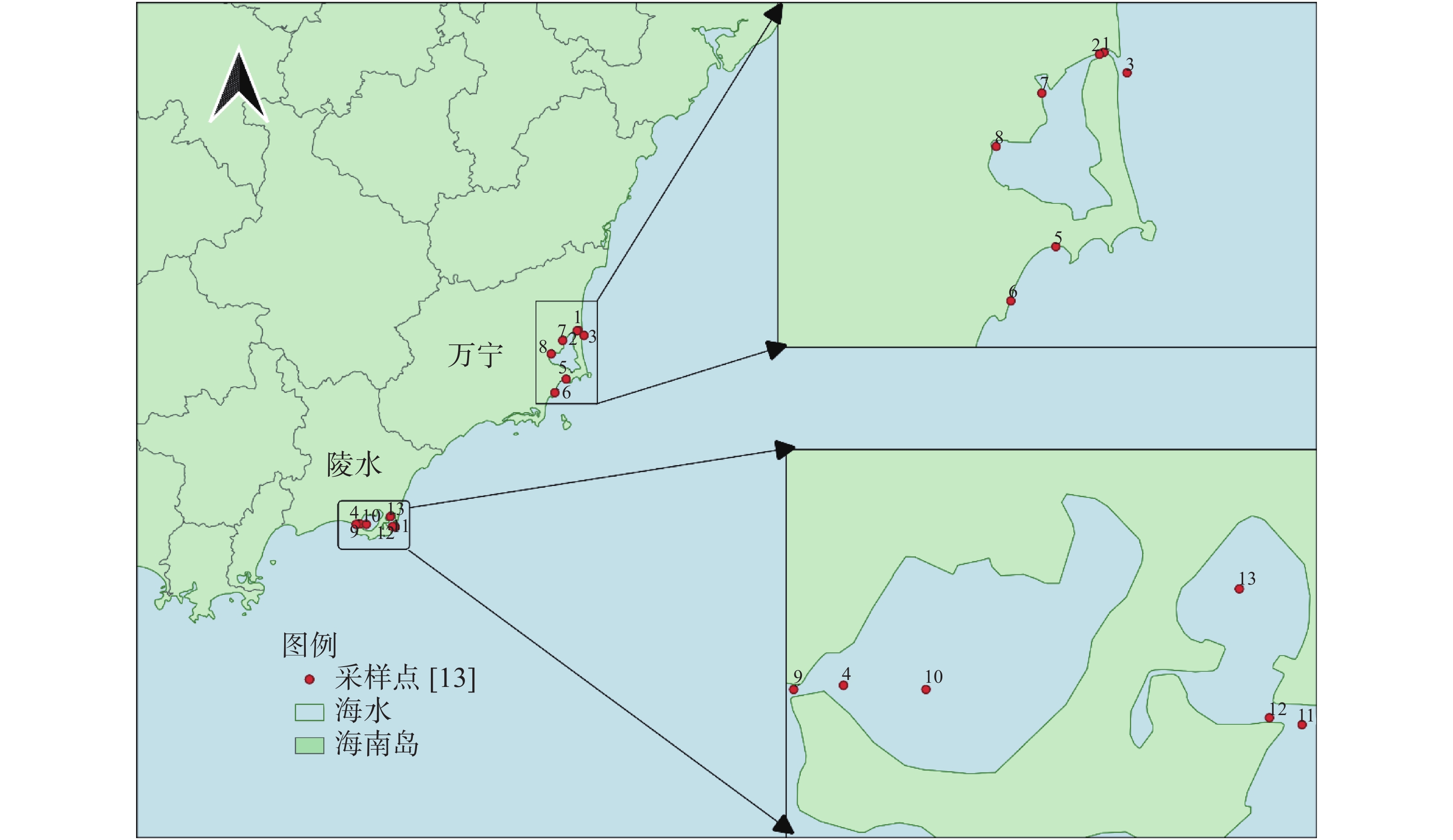

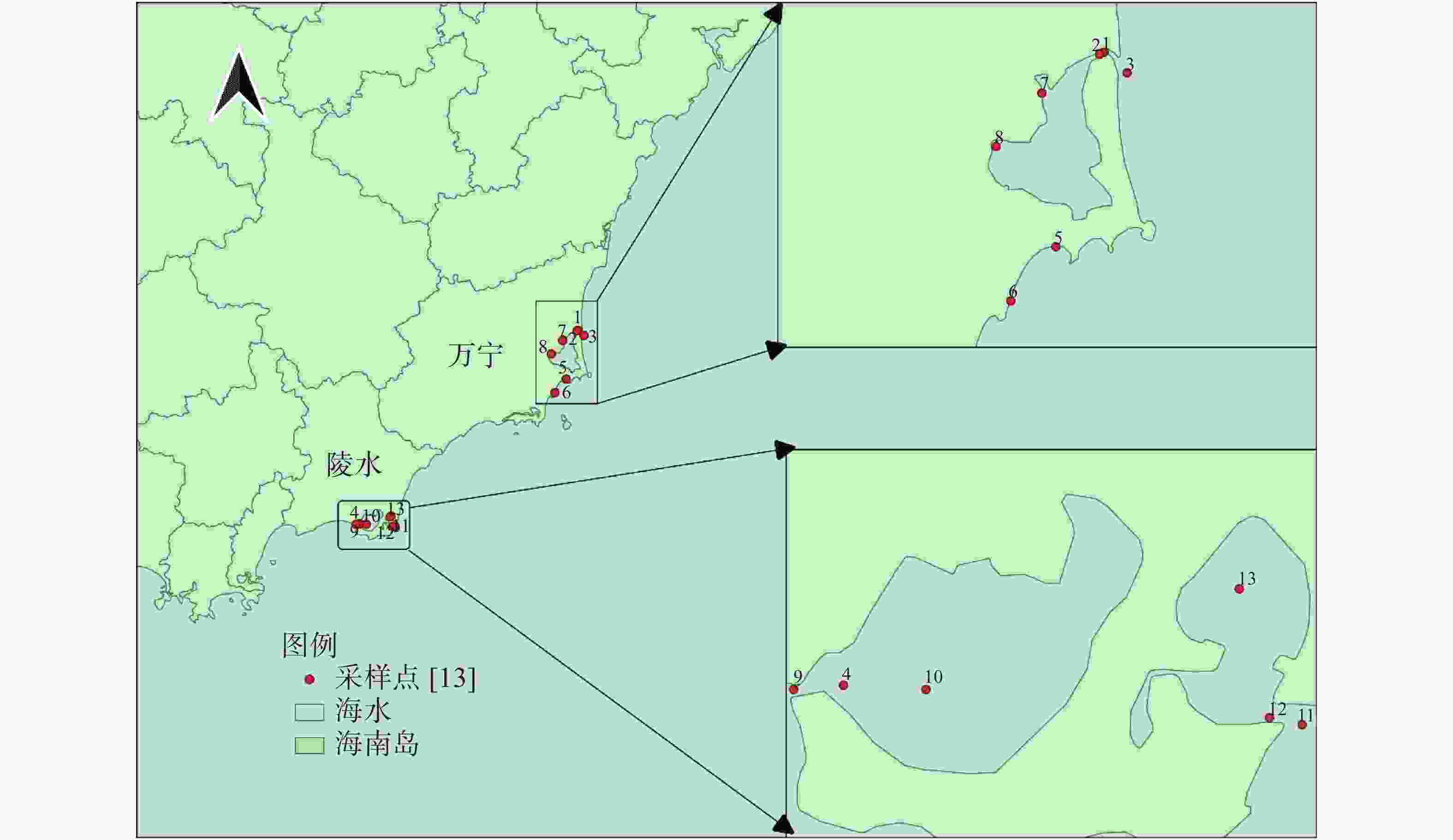

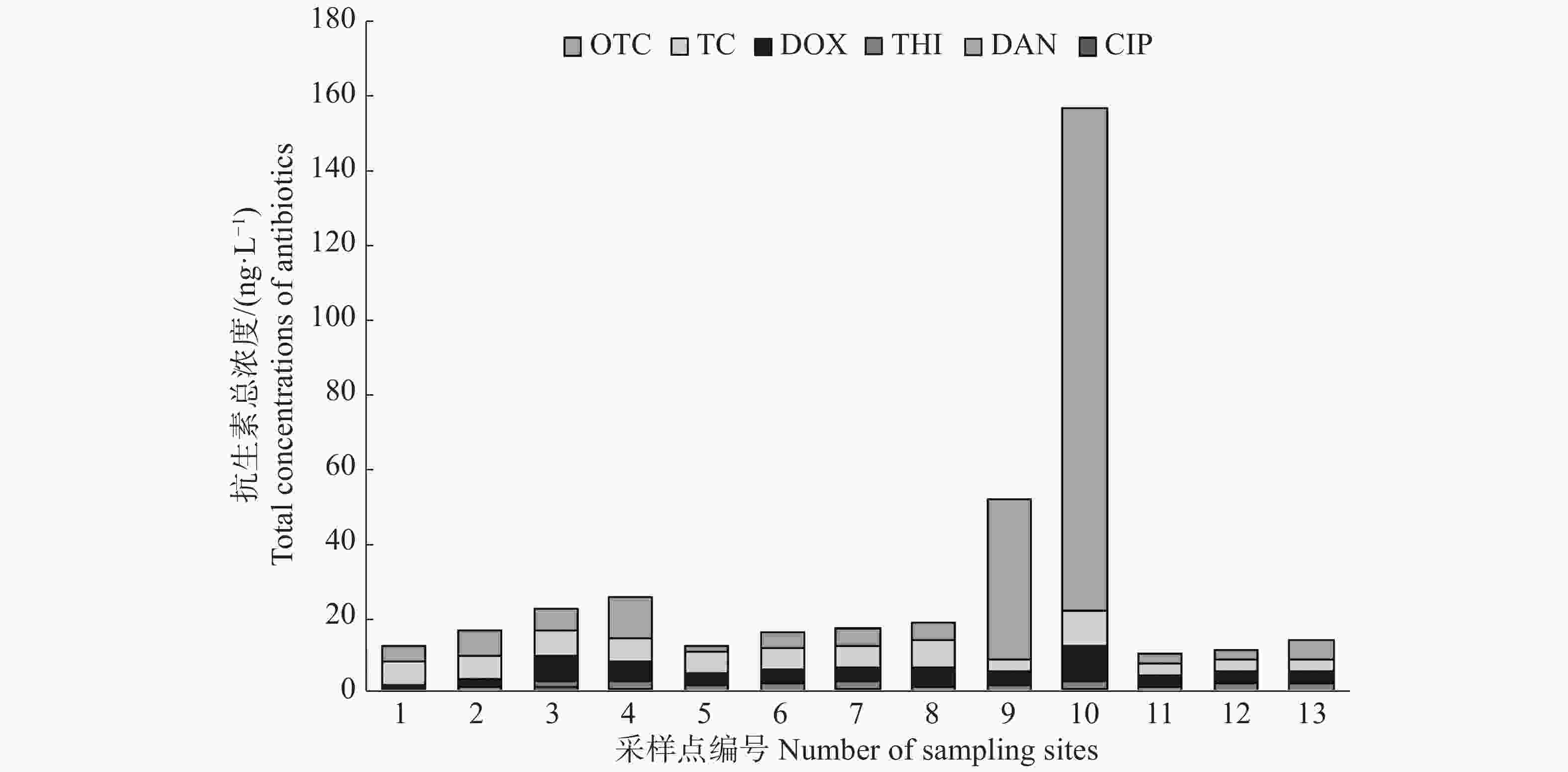
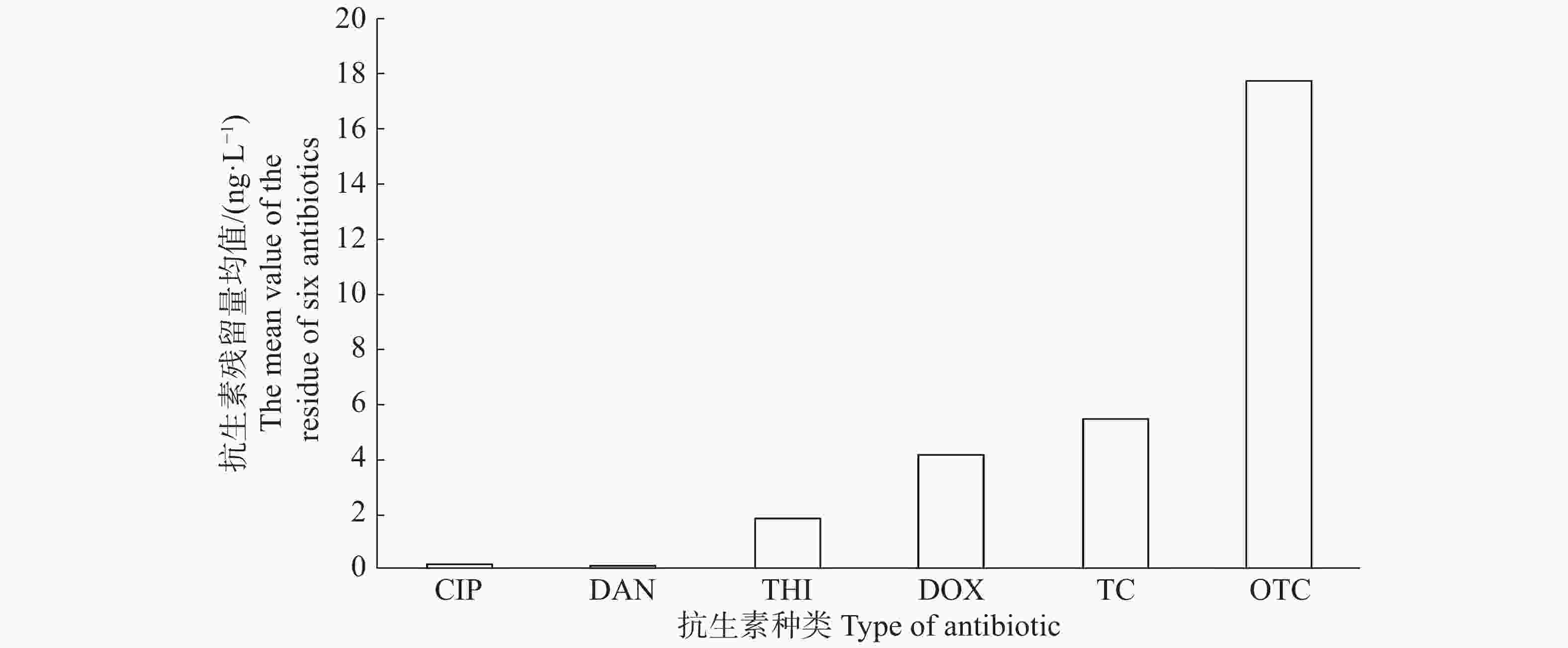
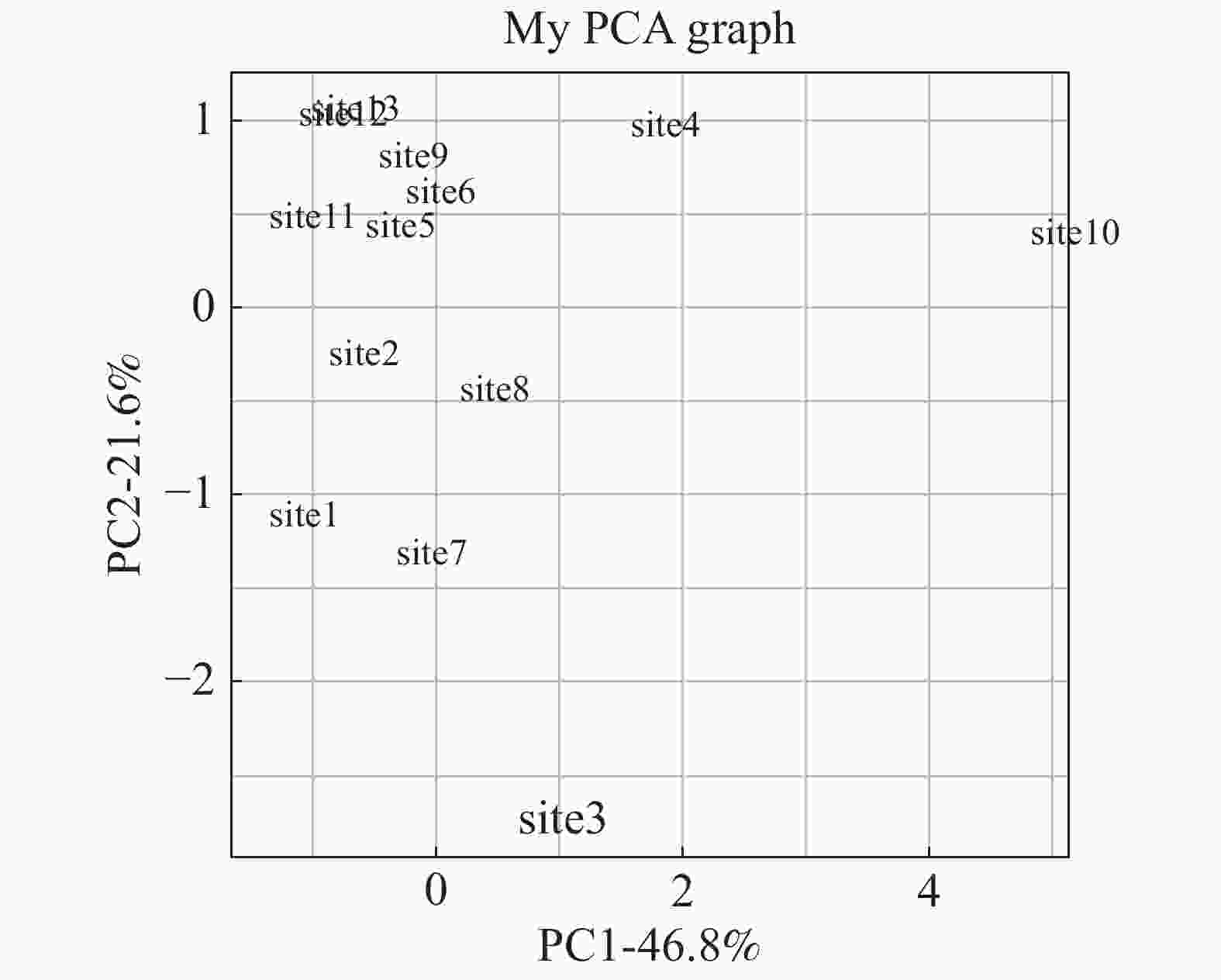

 DownLoad:
DownLoad:
